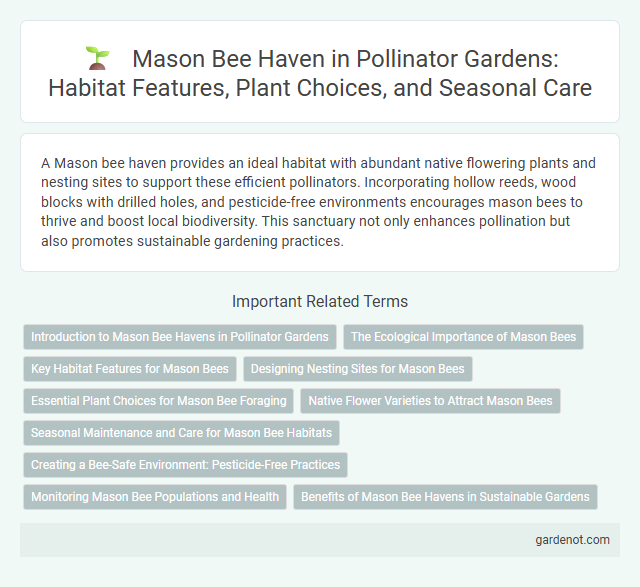A Mason bee haven provides an ideal habitat with abundant native flowering plants and nesting sites to support these efficient pollinators. Incorporating hollow reeds, wood blocks with drilled holes, and pesticide-free environments encourages mason bees to thrive and boost local biodiversity. This sanctuary not only enhances pollination but also promotes sustainable gardening practices.
Introduction to Mason Bee Havens in Pollinator Gardens
Mason bee havens provide essential nesting habitats for solitary mason bees, which are efficient pollinators in home gardens and agricultural settings. These havens typically include bundles of hollow reeds or drilled wood blocks that mimic natural nesting sites, encouraging mason bee populations to thrive. Incorporating a mason bee haven in a pollinator garden boosts biodiversity and significantly enhances fruit and flower pollination.
The Ecological Importance of Mason Bees
Mason bees play a crucial role in pollination by efficiently transferring pollen between flowers, supporting diverse plant species and enhancing garden biodiversity. Their solitary nature reduces competition for resources, allowing higher pollination rates compared to honeybees in some ecosystems. Creating a mason bee haven promotes sustainable agriculture by boosting fruit and seed production while maintaining ecological balance.
Key Habitat Features for Mason Bees
Mason bee havens feature compact nesting tubes and natural materials like bamboo or wood, providing essential shelter for these solitary pollinators. Moist soil and mud sources nearby support nest-building activities critical for mason bee reproduction. The presence of diverse native flowering plants ensures a continuous pollen and nectar supply during peak foraging seasons.
Designing Nesting Sites for Mason Bees
Designing nesting sites for mason bees involves creating shallow wooden blocks or bundles of hollow reeds with holes ranging from 5 to 10 millimeters in diameter to mimic natural cavities. Position these nests in sunny, sheltered locations facing east to benefit from morning warmth, and avoid exposure to heavy rain or strong winds. Providing diverse pollen sources nearby enhances the habitat, supporting mason bee populations for effective pollination.
Essential Plant Choices for Mason Bee Foraging
Mason bees rely heavily on native flowering plants such as wild cherries, blueberries, and fruit trees for pollen and nectar, which directly support their early spring foraging activities. Selecting early-blooming, pollen-rich plants like willows and maples enhances mason bee nutrition and increases their pollination efficiency. Incorporating a diverse range of native plants ensures a continuous food supply throughout the mason bee's active season, promoting healthy populations and robust pollination outcomes.
Native Flower Varieties to Attract Mason Bees
Native flower varieties such as coneflowers, black-eyed Susans, and wild bergamot provide essential nectar and pollen sources that attract and support Mason bees in a pollinator garden. These flowers bloom at varying times throughout the growing season, ensuring a continuous food supply for Mason bee populations. Planting diverse native species enhances habitat quality, promotes bee health, and increases pollination efficiency in the garden ecosystem.
Seasonal Maintenance and Care for Mason Bee Habitats
Seasonal maintenance of a Mason bee haven involves cleaning and replacing nesting materials in late fall to prevent disease and parasites. During early spring, ensure nesting tubes are dry and positioned to receive morning sunlight, enhancing bee activity and reproduction. Regular inspection and protection from predators throughout the season support a thriving Mason bee population essential for pollination efficiency.
Creating a Bee-Safe Environment: Pesticide-Free Practices
Creating a bee-safe environment in a Mason bee haven involves eliminating pesticides and adopting organic pest control methods to protect these vital pollinators. Utilizing natural repellents and encouraging beneficial insect populations helps maintain garden health without harmful chemicals. Providing clean water sources and planting diverse, native flowering plants further supports Mason bees' lifecycle and fosters a thriving, pesticide-free habitat.
Monitoring Mason Bee Populations and Health
Monitoring Mason bee populations and health involves regular inspections of nesting sites to assess population density, emergence rates, and signs of disease or parasites. Utilizing standardized observation protocols and data recording helps track the impact of environmental factors and garden management practices on bee vitality. Implementing non-invasive methods such as video monitoring or photography ensures minimal disturbance while providing valuable insights for conservation efforts in pollinator gardens.
Benefits of Mason Bee Havens in Sustainable Gardens
Mason bee havens boost sustainable gardens by enhancing pollination efficiency and increasing crop yields without the need for chemical inputs. These habitats support solitary mason bee populations, which are excellent early spring pollinators vital for fruit trees and native plants. Providing nesting materials and shelter promotes biodiversity and strengthens ecosystem resilience in organic and urban gardening systems.
Mason bee haven Infographic

 gardenot.com
gardenot.com